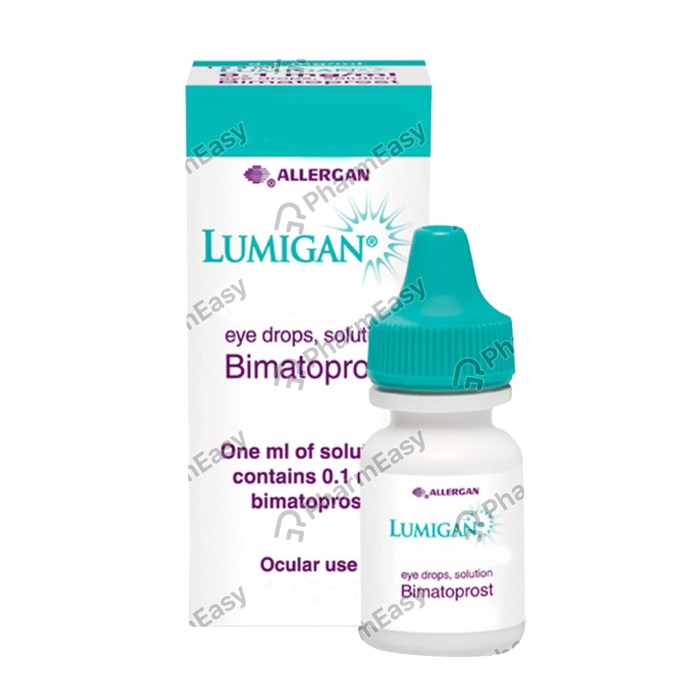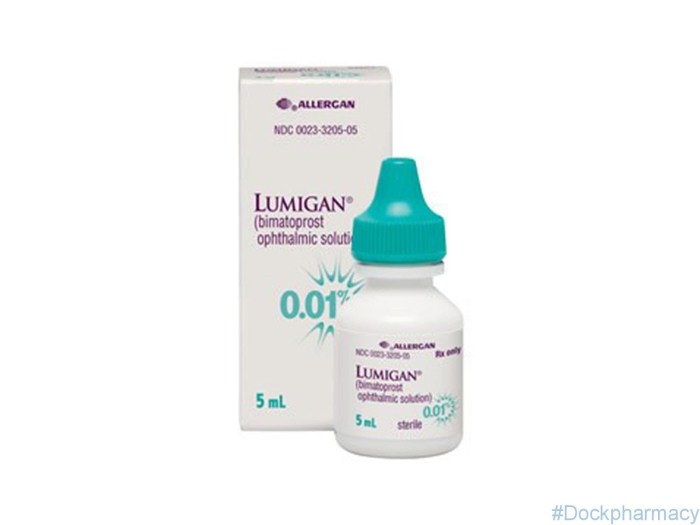Lumigan eye drops, a prescription medication, have become a widely recognized treatment for both glaucoma and eyelash hypotrichosis. This medication works by lowering pressure within the eye, which is crucial for managing glaucoma, a condition that can lead to vision loss. Additionally, Lumigan’s unique ability to stimulate eyelash growth has made it a popular choice for individuals seeking longer, thicker lashes.
Lumigan eye drops contain the active ingredient bimatoprost, a prostaglandin analog that effectively reduces intraocular pressure by increasing the outflow of aqueous humor from the eye. This mechanism of action makes Lumigan an effective treatment option for open-angle glaucoma and ocular hypertension. The medication is also available in different strengths and formulations to cater to individual needs.
Patient Information and Education

Lumigan (bimatoprost ophthalmic solution) is a prescription medication used to treat open-angle glaucoma and ocular hypertension. It lowers pressure inside the eye by increasing the outflow of fluid. This helps prevent damage to the optic nerve, which can lead to vision loss.
Understanding Lumigan
Lumigan is a prostaglandin analog, a type of medication that works by increasing the drainage of fluid from the eye. It is available as an ophthalmic solution, which is applied to the eye as drops. Lumigan is typically used once a day, at bedtime.
How to Use Lumigan
- Wash your hands thoroughly before using Lumigan.
- Tilt your head back and pull down your lower eyelid to create a pouch.
- Place one drop of Lumigan into the pouch.
- Close your eye gently for one minute.
- Apply the drops to the affected eye(s) as directed by your doctor.
Possible Side Effects
Like all medications, Lumigan can cause side effects. Some common side effects include:
- Eye irritation
- Redness
- Itching
- Blurred vision
- Darkening of the iris (colored part of the eye)
- Growth of eyelashes
Most side effects are mild and temporary. However, some side effects can be serious. If you experience any unusual or severe side effects, contact your doctor immediately.
Potential Risks
- Eye irritation: Lumigan can cause eye irritation, such as burning, stinging, and redness. This is a common side effect that usually resolves within a few days.
- Darkening of the iris: Lumigan can cause a gradual darkening of the iris (colored part of the eye). This effect is more common in people with lighter-colored irises. The darkening is usually permanent.
- Growth of eyelashes: Lumigan can cause the eyelashes to grow longer, thicker, and darker. This effect is more common in people with lighter-colored eyelashes.
- Allergic reaction: Some people may experience an allergic reaction to Lumigan. Symptoms of an allergic reaction can include itching, swelling, and redness of the eye.
- Pregnancy and breastfeeding: It is important to talk to your doctor about the risks and benefits of using Lumigan if you are pregnant or breastfeeding.
Common Questions and Concerns
- How long does it take for Lumigan to work? It may take several weeks for Lumigan to lower your eye pressure.
- What if I miss a dose of Lumigan? If you miss a dose of Lumigan, apply it as soon as you remember. However, if it is almost time for your next dose, skip the missed dose and continue with your regular schedule. Do not double the dose.
- Can I wear contact lenses while using Lumigan? You should wait at least 15 minutes after applying Lumigan before putting in your contact lenses.
- Can I use Lumigan in both eyes? Yes, Lumigan can be used in both eyes, but only if your doctor prescribes it for both eyes.
- Can I use Lumigan with other eye medications? You should always talk to your doctor before using Lumigan with other eye medications.
- What should I do if I accidentally get Lumigan in my mouth? If you accidentally get Lumigan in your mouth, rinse your mouth with water.
- What should I do if Lumigan gets in my eye? If Lumigan gets in your eye, rinse your eye with water.
- Where can I find more information about Lumigan? You can find more information about Lumigan on the manufacturer’s website or by talking to your doctor or pharmacist.
Additional Resources
- The National Eye Institute (NEI): The NEI is a federal government agency that conducts research on eye diseases and provides information to the public. Their website has a wealth of information on glaucoma, including treatment options. You can find the NEI website at: [Website address]
- The Glaucoma Research Foundation: The Glaucoma Research Foundation is a non-profit organization dedicated to finding a cure for glaucoma. Their website provides information on glaucoma, including research updates, clinical trials, and support resources. You can find the Glaucoma Research Foundation website at: [Website address]
Research and Development: Lumigan Eye Drops
Lumigan, the brand name for bimatoprost ophthalmic solution, has been a significant advancement in the treatment of various eye conditions. Ongoing research and development efforts are continuously exploring new possibilities to enhance its effectiveness and expand its applications. This section delves into the latest developments related to Lumigan, including advancements in formulations, delivery systems, and potential applications, shedding light on the future of bimatoprost in ophthalmology.
Timeline of Key Milestones in the Development of Lumigan
The development of Lumigan has been a journey marked by significant milestones that have led to its current status as a widely used treatment option.
- 1996: Bimatoprost, the active ingredient in Lumigan, was initially synthesized.
- 1998: The first clinical trials for bimatoprost began.
- 2001: Lumigan was approved by the FDA for the treatment of open-angle glaucoma and ocular hypertension.
- 2008: Lumigan was approved by the FDA for the treatment of hypotrichosis (insufficient eyelashes).
- 2013: The generic version of bimatoprost became available in the market.
These milestones highlight the continuous research and development efforts that have brought Lumigan to the forefront of ophthalmic treatment options.
Ethical Considerations

The use of Lumigan eye drops, like any medication, comes with ethical implications that need careful consideration. These implications extend beyond the direct impact on the patient’s health and encompass broader societal and professional aspects.
Potential Misuse and Off-Label Use
The potential misuse and off-label use of Lumigan raise ethical concerns. Misuse can occur when patients use the medication without a proper prescription or for purposes other than those intended. Off-label use, while not always unethical, requires careful consideration of the risks and benefits for each individual patient.
- Misuse: Patients may use Lumigan without a prescription, potentially leading to adverse effects or interactions with other medications. This misuse can also contribute to the development of antibiotic resistance, a significant public health concern.
- Off-Label Use: While Lumigan is approved for the treatment of glaucoma and ocular hypertension, it may be used off-label for other conditions. This practice requires careful assessment of the potential benefits and risks for each individual patient, considering the lack of extensive clinical trials specifically for these off-label uses.
Impact on Patient Autonomy
The use of Lumigan can also impact patient autonomy. While informed consent is crucial before any medical treatment, patients may feel pressured to use the medication due to potential side effects of untreated glaucoma or ocular hypertension.
- Informed Consent: Healthcare professionals must ensure patients understand the benefits and risks of Lumigan, including potential side effects and long-term implications. This information must be presented in a clear and understandable manner, allowing patients to make informed decisions about their treatment.
- Patient Preferences: Patients should be actively involved in their treatment decisions, and their preferences and values should be respected. This includes considering alternative treatment options and discussing the potential benefits and risks of each option.
Role of Healthcare Professionals, Lumigan eye drops
Healthcare professionals play a critical role in addressing the ethical considerations surrounding Lumigan use. They must inform patients about the potential benefits and risks of the medication, including the possibility of side effects and long-term implications.
- Transparency and Disclosure: Healthcare professionals must be transparent about the potential benefits and risks of Lumigan, including the possibility of side effects and long-term implications. They should also discuss alternative treatment options and the patient’s individual risk factors.
- Patient Education: Healthcare professionals should provide patients with clear and concise information about Lumigan, including its purpose, how to use it, and potential side effects. This information should be presented in a way that is easily understood by the patient, regardless of their level of medical knowledge.
Marketing and Promotion of Lumigan
The marketing and promotion of Lumigan also raise ethical considerations. While promoting a medication is essential for its accessibility and use, it must be done responsibly, avoiding misleading claims or exaggerating its benefits.
- Accurate Information: Marketing and promotional materials should provide accurate information about Lumigan, including its intended use, potential side effects, and limitations. This information should be presented in a clear and understandable manner, avoiding misleading claims or exaggerating its benefits.
- Targeting and Accessibility: Marketing efforts should target appropriate audiences and ensure that information about Lumigan is accessible to all potential users, regardless of their socioeconomic status or geographic location.
In conclusion, Lumigan eye drops offer a multifaceted approach to treating both glaucoma and eyelash hypotrichosis. Its effectiveness in managing intraocular pressure and promoting eyelash growth has made it a valuable tool for healthcare professionals and patients alike. However, it’s essential to understand the potential side effects and risks associated with Lumigan use and to consult with a healthcare provider for personalized guidance and treatment options.
Lumigan eye drops, also known as bimatoprost, are a popular treatment for glaucoma. They work by increasing the outflow of fluid from the eye, reducing pressure and protecting the optic nerve. While Lumigan focuses on fluid management, other medications like fluocinolone acetonide , a corticosteroid, are used to reduce inflammation in the eye. Lumigan is typically prescribed for long-term use, and it’s important to follow your doctor’s instructions carefully.